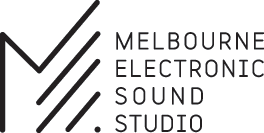Warren Burt
MESS Commissioned Artist
Warren is knitted into the very fabric of Australian experimental and electronic music. His arrival from the US in 1975 to be part of the first teaching cohort at the newly minted La Trobe University Music Department was a seismic event in the development of the form in this country.
How did you first get involved with synths and electronic sound?
I first got fascinated with electronic sound with one of the themesongs from the Long John Nebel overnight talk show on WNBC radio in New York. I think the tune used either an Ondes Martinot or a Theremin. I also was fascinated with the “Monitor Beacon,” the electronic tag-theme from NBC Radio’s weekend magazine show, Monitor. Then at my local public library, I discovered a record of music by Olivier Messiaen – Three Petite Liturgies of the Divine Word – which had a prominent part for Ondes Martinot. This was all in high school. So when I went to University (State University of New York at Albany), and encountered Joel Chadabe and the Moog Synthesizer (several generations of that), I took to it like a duck takes to water. I remember Joel joking with me when I expressed interest in playing with the Moog, he said “I’m warning you kid, the first one’s free.” He was right. Playing with electronic synthesizers was wonderfully addictive and fascinating.
How would you describe the sounds you make today?
Where do you find inspiration, what motivates you?
I can be inspired by many things, all of my senses seem to inform my relationship with sound to a certain extent. It could be some kind of visual stimulus like a landscape, a colour or a visual texture, but also things like food, a smell, a conversation or a physical experience. What matters more is my state of mind while experiencing that thing. It’s more about the reception of the thing and if I am open to creative possibilities at that point in time. A lot of the work I make is directed by a possibility, a connection of things, or a way to use sound to explore something from a different perspective.




